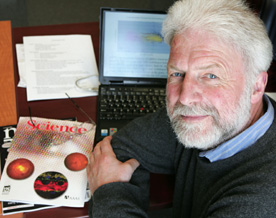Donal Hickey focuses on biology's big picture

Donal Hickey
Photo by Andrew Dobrowolskyj
Donal Hickey has spent his career looking at the tiniest components of life. Now he is focused on biology’s big picture.
Hickey, an accomplished researcher in both genetics and genomics, has joined the University’s Biology Department as Canada Research Chair in Genome Evolution, Tier 1. As such, he is Concordia’s man at the forefront of a very new field of biology: comparative genomics – or, as he calls it, “genetics at zoom-out.”
Having spent his career examining genes, Hickey is now studying patterns of genome evolution — how genomes, the collective sets of genes of a species, change from generation to generation.
It’s an area of research that has only recently been made possible by the advance of technology, including the mapping of the human genome and the advent of supercomputers that can simulate models based on enormous sets of data.
“There are still lots of people looking at particular genes,” Hickey explained. “I’m interested in genes in the larger sense, collectively, and in variations between them.” In other words, as a biologist, he is looking at “the forest instead of the individual trees” — or, indeed, comparing different forests.
Hickey is trying to make sense out of the phenomenon by which sets of genes get passed along from parents to offspring in a way that mixes genes up but still leaves certain chunks of genes intact, like beads on a string.
Although genes from both parents get mingled in their offspring, it’s not as though they are being “put in a blender,” he observed. “They don’t get completely homogenized.”
Hickey is interested in why genes behave that way. “Why do we recombine our genes? Why don’t individuals just pass along the genes they have? Or if they’re going to mix them up, why don’t they mix them up more?”
Small differences in human genomics make for differences between people. Each human has three billion base pairs of DNA, and the vast majority of these are the same, because we’re all humans.
“What’s interesting is the one-tenth of one per cent, which is still three million, where you’re different from me,” Hickey said. They somehow define “the variations within the species.”
In practical terms, such differences may speak to whether a person is susceptible to a disease. Hickey’s focus is on the quantitative aspect, however.
“This question has a lot of practical applications, but a number of people including myself are saying,,isn’t this an interesting phenomenon? How does it work, and why does it work like that?”
Using computer simulations and working with hypothetical genomes, Hickey studies how the process of mutation unfolds over multiple generations — up to thousands of them.
Computer simulation is the only way to pursue that question, he said, because examining the process over thousands of generations “is not an experiment you can do.”
The one practical application of comparative genomics Hickey is involved in is that of “DNA barcoding,” forming a database of genomes that can help tell one species from another just by comparing samples of DNA.
“That’s very useful for people who study real biology in the woods,” he said. “We are compiling a list for a given piece of DNA for each species, and putting this list in a searchable database. Once this database is compiled, when you find a leaf in a tropical rainforest or a salamander under a rock, all you would have to do is take a little sample to put a name on it.”The idea, he said, “is to make all of biodiversity Google-searchable.” Now that’s a big picture.